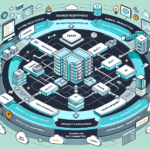Designing an enterprise network topology requires careful planning and consideration of business needs, scalability, security, and performance. Below are the steps and best practices to guide you:
1. Understand Business Requirements
- Identify goals: Understand the business objectives, applications, services, and users the network will support.
- Capacity planning: Forecast bandwidth requirements based on current and future growth.
- Compliance: Consider legal and regulatory requirements (e.g., GDPR, HIPAA).
2. Assess Current Infrastructure
- Perform an audit of existing network components, including routers, switches, firewalls, servers, storage, and endpoints.
- Identify bottlenecks, outdated hardware, and software that need upgrades.
3. Choose the Right Topology
Select the topology that best meets your organization’s needs. Common topologies include:
– Star Topology: Centralized control for simplicity and scalability (e.g., data center-centric).
– Mesh Topology: High redundancy and fault tolerance, ideal for critical systems.
– Hybrid Topology: Combines multiple topologies for flexibility.
4. Design for Scalability
- Segment the network: Divide the network into logical segments (e.g., VLANs) for performance and security.
- Load balancing: Distribute traffic across multiple resources (e.g., servers, firewalls).
- Cloud integration: Incorporate hybrid cloud setups with seamless connectivity between on-premises and cloud environments.
5. Implement Redundancy
- Use redundant hardware (e.g., dual routers, switches, power supplies) to avoid single points of failure.
- Implement failover systems for high availability (e.g., VRRP/HSRP for routers, clustering for servers).
6. Security Considerations
- Network segmentation: Use firewalls and access control lists (ACLs) to segment the network and minimize the attack surface.
- Zero Trust Architecture: Verify every device, user, and connection before granting access.
- DDoS protection: Deploy solutions to guard against distributed denial-of-service attacks.
- Encryption: Secure data in transit using protocols like HTTPS, VPNs, and IPSec.
7. Optimize for Performance
- QoS (Quality of Service): Prioritize critical applications (e.g., VoIP, video conferencing) to ensure stable performance.
- Monitoring: Implement tools like SNMP, NetFlow, or APM to monitor performance and address issues proactively.
- Edge computing: Deploy resources closer to end-users to reduce latency.
8. Virtualization and Containerization
- VMs: Use virtualization to improve resource utilization and flexibility for servers.
- Kubernetes: Leverage container orchestration to run microservices efficiently.
- SDN (Software-Defined Networking): Centralize network management and improve agility.
9. GPU Computing for AI and ML
- If deploying AI/ML workloads, ensure dedicated high-performance GPU clusters are integrated into the network.
- Implement high-speed interconnects like NVLink or InfiniBand for GPU communication.
10. Backup and Disaster Recovery
- Offsite replication: Store backups in a secondary location or cloud.
- RTO/RPO planning: Define acceptable recovery time objectives (RTO) and recovery point objectives (RPO).
- Testing: Regularly test your disaster recovery plan to ensure reliability.
11. Documentation
- Create detailed network diagrams and documentation for future reference. Include IP address schemes, subnetting, device configurations, and logical connections.
12. Future-Proofing
- Plan for emerging technologies like 5G, IoT, and edge computing.
- Invest in modular hardware and scalable architecture to accommodate growth without requiring a complete redesign.
Tool Recommendations
- Network Design Tools: Cisco Packet Tracer, SolarWinds Network Topology Mapper, Visio.
- Monitoring Tools: Nagios, Zabbix, PRTG Network Monitor.
- Backup Solutions: Veeam, Commvault, Rubrik.
Example Enterprise Network Design
A typical enterprise network might include:
– Core Layer: High-performance switches and routers connecting critical systems (data center and internet gateway).
– Distribution Layer: Aggregates traffic from access switches and enforces policies.
– Access Layer: Connects endpoints like PCs, printers, and IoT devices.
– Data Center: Virtualized servers, storage, and GPU clusters for AI/ML workloads.
– Cloud Integration: Secure connectivity to public clouds (AWS, Azure, GCP).
– Edge Locations: Offices with edge devices and secure site-to-site VPNs.
Final Note
Designing an enterprise network topology is an iterative process. Regularly review and update the design to align with evolving business needs, technology trends, and security threats.




